By Gail Cochrane
Liberty Wildlife Volunteer
The rains of winter have brought about a brilliant flush of wildflowers, and in the coming weeks clouds of blooms will enfold our native trees. The blossoming and fruiting of annual wildflowers and legume trees like ironwoods, Palo Verdes and acacias feed desert birds and mammals and attract insects that sustain baby birds. This is the season when pollinators such as native bees become our most important players.
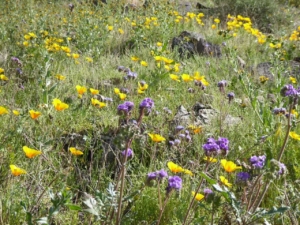 There are around 1000 different species of bees in the Sonoran Desert. Specifically, the area around Tucson has perhaps more different kinds of native bees than anywhere else in the world.
There are around 1000 different species of bees in the Sonoran Desert. Specifically, the area around Tucson has perhaps more different kinds of native bees than anywhere else in the world.
These native bees come in many shapes and sizes and with many different habits. The world’s smallest bee, Perdita 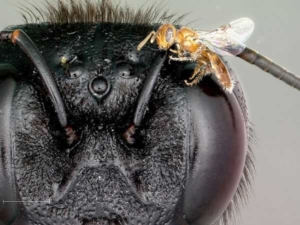 minima lives here, growing to just 2 millimeters in size. You have probably noticed Carpenter bees from the genus Xylocopa bumbling around flowers in your yard. These gentle bees are 1 ½ inches long.
minima lives here, growing to just 2 millimeters in size. You have probably noticed Carpenter bees from the genus Xylocopa bumbling around flowers in your yard. These gentle bees are 1 ½ inches long.
Most desert bees are solitary rather than colony bees. Herbivores, they feed on pollen, nectar and plant oils. Some species live in underground burrows, some hollow out the pithy stems of plants, and others live in tunnels abandoned by wood boring beetles. Many solitary bees secrete a waxy substance to line their burrows, capturing humidity inside and keeping fungi out.
Plants depend on bees and other pollinators, allowing for fruits and seeds that create new generations of their species. Birds and mammals eat the fleshy berries and fruits promised by pollination. Bee tunnels aerate the soil at the base of plants and direct rainwater to deep underground roots. Even bee waste (poop) is helpful, as it adds nutrients to the soil. Further enriching the desert biome, some bees become food for lizards, mammals, insects and spiders.
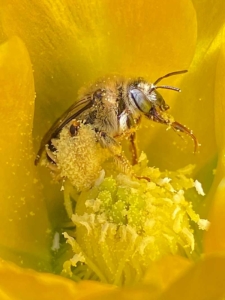 Unlike colonies of honey bees that live in hives, solitary bees raise their young in individual brood cells created in a variety of ways. Mason bees use water and mud to make adobe nests. Leaf cutter bees cut circular pieces of leaves to make cell walls. Other bees collect pebbles, plant hairs and floral resins for brood cell building materials.
Unlike colonies of honey bees that live in hives, solitary bees raise their young in individual brood cells created in a variety of ways. Mason bees use water and mud to make adobe nests. Leaf cutter bees cut circular pieces of leaves to make cell walls. Other bees collect pebbles, plant hairs and floral resins for brood cell building materials.
As you walk among the flowering trees of the desert this spring, take time to listen to the resonant buzz of bees. Stop and admire the small, industrious workers humming among the blooms. Rather than insects to be afraid of, these critters are incredibly important to our web of life – pollinating 80% of our native flowering plants.
Captions:
Cactus Bee pollinates prickly pear, saguaro and cholla cacti. Photo by Jengod – Own work, CC BY-SA 4.0
Perdita minima on the head of a Carpenter Bee. Photo by Stephen Buchmann
Mexican Poppies and Scorpion Weeds on South Mountain. Photo by G Cochrane
Kid Stuff
Nurturing Nature
By: Carol Suits
Liberty Wildlife Volunteer
Be a Superhero this month by helping nature get ready for spring.
Make a “Nester” – A holder for good nesting material.

Use these materials to build a nester
Dead twigs
Dead leaves
Dry grass
(no pesticides)
Feathers
Plant fluff
Moss
Bark strips
Pine needles
Don’t use these materials
Dryer lint
Plastic strips
Aluminum foil
Cellophane
Tinsel
String
Webbing/Mesh
(like onion bags)
This website has ideas for making nesters/holders.
https://www.greatstems.com/2013/05/wildlife-projects-for-kids-nesting-materials.html
Think about bird safety. Can birds land and fly away without getting trapped? For this reason, never use mesh bags — they can trap feet and legs or be a strangulation hazard.
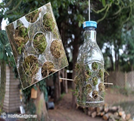
Be sure to “test” your nester! Can birds easily pull out the material?
Be sure to join us March 11th when we start our “Partner Pals Program” with our Education Ambassadors!
If you would like more information about the Superhero Club, please contact Carol Suits, carols@libertywildlife.org for details.
Puzzle!
https://www.jigsawplanet.com/?rc=play&pid=1262c1661301
***
 Try some of these and be a Superhero for Nature!
Try some of these and be a Superhero for Nature!
| Actions To Take | Habitat Activities |
| Make | Make a Nature Notebook for your habitat work |
| https://thegreenhour.org/nature-notebook/fall-nature-notebook/ | |
| Draw | Draw a habitat map of your backyard or schoolyard |
| Habitat need= food | Make an orange cup feeder |
| Use recycled stuff to make bird feeders | |
| Make a pumpkin or Cheerios bird feeder | |
| Make a one-stop bee café | |
| Habitat need = water | Make a puddle patch for butterflies |
| https://www.youtube.com/watch?v=bsZYMH5xRTA | |
| Make watering places for bees and butterflies | |
| Make a birdbath | |
| https://kids.nationalgeographic.com/books/article/make-a-birdbath/ | |
| Habitat need = shelter | Get help to build a wildlife home for birds, bats, bees, toads, |
| insects, butterflies. Pick animals you’d like to help. | |
| Find out | Find out and draw or list which plants are pollinator friendly |
| Draw | Draw or list pollinators you see in your nature journal |
| Take photos | Take photos of the pollinators visiting your yard |
| Make posters | Make pollinator posters to put up in school and bring one |
| to the next Superhero Club meeting | |
| Make | Make a bee house for solitary bees – https://tinyurl.com/Solitary-bees-and-houses |
| All items with links and explanations can be found at | |
| https://libertywildlife.org/nature-news-september-2022/ | |
| https://libertywildlife.org/nature-news-october-2022/ | |
***
Explore Nature
When you go outside at home, school, or anywhere, can you discover nature’s sounds and beauty? What words or pictures come to mind?
See it! Hear it! Smell it! Feel it! Write it! Draw it!
This activity page is a fun way to get outside and explore nature!
Meet Our Animal Ambassadors!
By Claudia Kirscher
Liberty Wildlife Volunteer
The Swainson’s Hawk is a widespread hawk of Western North America during spring and summer. Every autumn, it does one of the longest hawk migrations south for the winter to as far as Argentina and returns to North America to its spring nesting grounds….a 12,000-mile round trip ! They may also winter in Mexico and Central America. These hawks are one of the rare raptors to migrate in large flocks, sometimes numbering in the hundreds or thousands.
They favor open plains, grasslands, and agricultural areas foraging for insects, small rodents, lizards, and small birds. Swainson’s Hawks are often seen following tilling tractors grabbing ploughed up insects and rodents. There are two color variations, light and dark morphs.
Their populations have declined due to habitat loss of agricultural lands to housing development and use of pesticides.
Liberty Wildlife has 4 non-releasable Swainson’s Hawks.
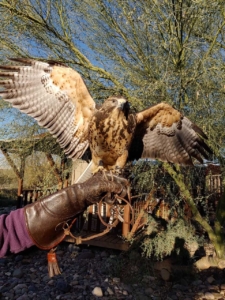 Addison arrived in 2021 as a 1st-year bird from Yuma, AZ. She had folding fractures due to poor nutrition in captivity plus habitation. She has not yet molted into her full adult plumage.
Addison arrived in 2021 as a 1st-year bird from Yuma, AZ. She had folding fractures due to poor nutrition in captivity plus habitation. She has not yet molted into her full adult plumage.
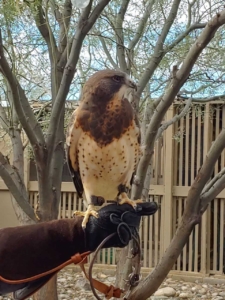
Cassidy came to us in 2020, a 1st-year bird, from Sierra Vista, Az. She had been caught in barbed wire, broke her wing, and showed signs of an electrical injury which required subsequent partial wing tip amputation.
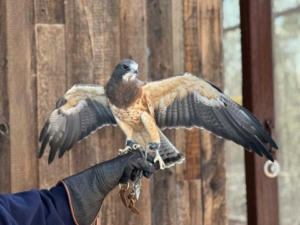
Sundance arrived in 2012 from Sierra Vista as a first-year juvenile having fallen from a nest. He sustained an impact injury to the abdominal area and also showed signs of imprinting.
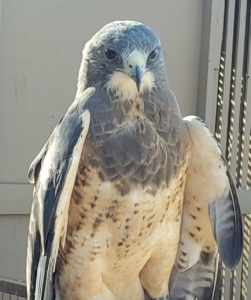
Etta came to Liberty in 2012 from Sierra Vista as a 3-year-old. She had an old fused right wing/elbow fracture sustained as a juvenile. She is unable to fly.
Come on down to visit and hear their stories!


